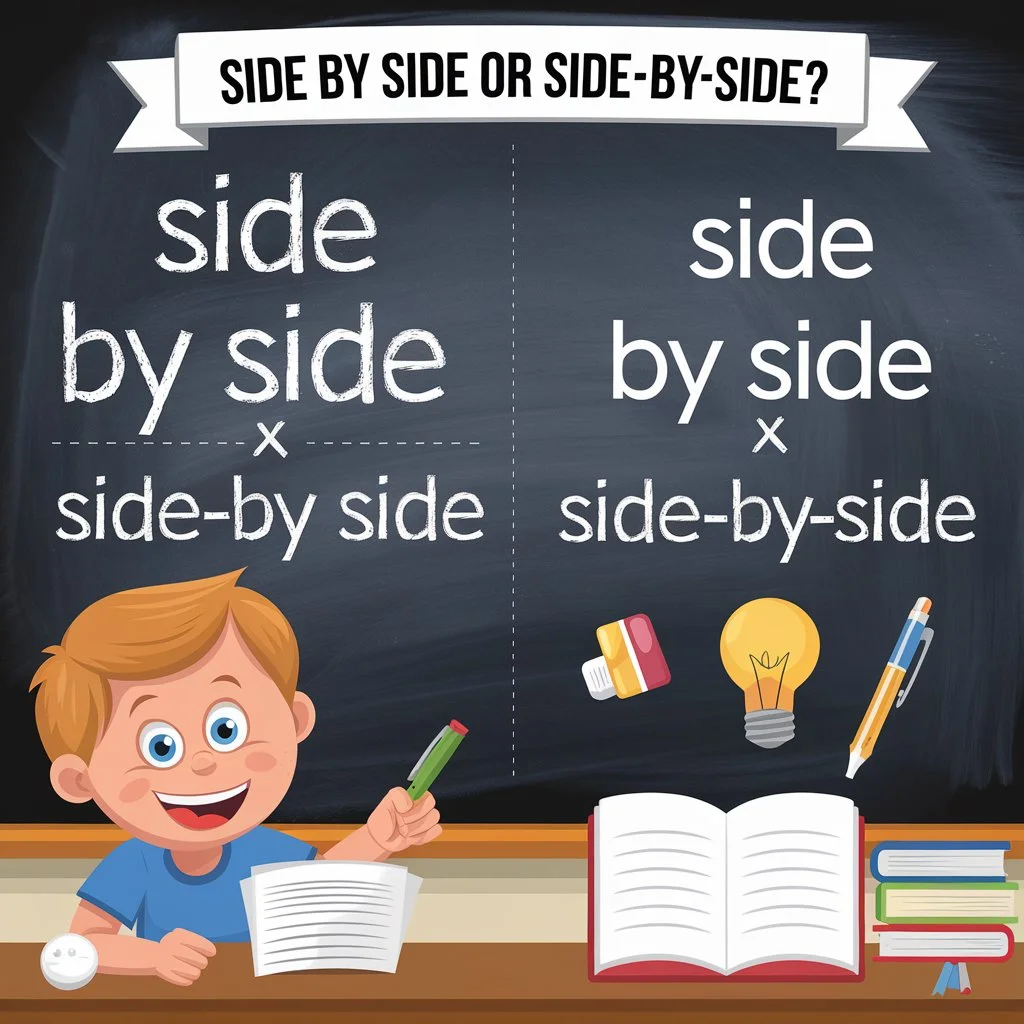“Explore the benefits of side-by-side comparisons to enhance decision-making. Discover how to effectively analyze options and make informed choices in various aspects of life, from products to services. Learn practical tips for conducting thorough side-by-side evaluations that lead to better outcomes.”
When it comes to using the phrase “side by side”, many wonder whether to hyphenate it as “side-by-side.” Understanding the rules of hyphenation in English can clarify this confusion. Let’s explore the guidelines for using these variations effectively!
Side By Side or Side-By-Side: Hyphenated or Not?
You should hyphenate “side-by-side” when you’re using it as an adjective to modify a noun in a sentence. On the other hand, use “side by side” unhyphenated when it functions as a phrase noun that is not modifying any object in the sentence. Generally, “side-by-side” will appear directly before a noun, while “side by side” will often be found at the end of a clause.
Examples of When to Use “Side By Side”
Let’s look at instances when the unhyphenated version is appropriate. Despite the growing popularity of the hyphenated version, we should still use the unhyphenated form for grammatical accuracy.
Examples
- They stood side by side.
- We were side by side all day.
- You are side by side.
- The dogs are side by side.
- The houses stand side by side.
- They walked side by side through the park.
- The two cars parked side by side in the driveway.
- We placed the books side by side on the shelf.
- The children sat side by side during the movie.
- The paintings were displayed side by side in the gallery.
- The students worked side by side on the project.
- The cats slept side by side on the couch.
- We stood side by side at the concert.
- The two friends lived side by side for years.
- The houses are built side by side in the neighborhood.
- The flags waved side by side in the breeze.
- The puppies played side by side in the yard.
- She held the photographs side by side for comparison.
- They enjoyed their coffee side by side at the café.
- The teams competed side by side in the tournament.
Examples of When to Use “Side-By-Side”
Now, let’s focus on the hyphenated version. Following the AP Style guide, we use “side-by-side” when we need to modify a noun. Observe how it functions in these examples:
Examples
- The side-by-side houses are part of the aesthetic.
- The side-by-side pupils never leave each other.
- They’re a side-by-side couple that never breaks apart.
- Can we get a side-by-side photo?
- Let’s make a side-by-side comparison.
- The side-by-side comparisons helped clarify the differences.
- They bought a side-by-side refrigerator for their kitchen.
- The side-by-side cars raced down the track.
- The side-by-side results showed significant improvement.
- The side-by-side installation of the software was seamless.
- The side-by-side units provide extra storage space.
- The side-by-side display allowed for easy viewing.
- They created a side-by-side chart for their presentation.
- The side-by-side cabins were perfect for family gatherings.
- The side-by-side photos highlighted the changes over time.
- The side-by-side arrangement made the layout more appealing.
- The side-by-side commentary added depth to the discussion.
- The side-by-side interview format encouraged collaboration.
- The side-by-side graphs illustrated the data effectively.
- They featured a side-by-side analysis in the report.
Is Side By Side Hyphenated in AP Style?
According to AP style rules, hyphens connect closely related words, helping readers better understand the text. Hyphenated words serve as a single adjective that combines two or more words into one unit in a sentence. If there is no noun present to modify, the AP style dictates that all words should remain unhyphenated.
Examples
- The two friends stood side by side during the ceremony.
- They placed the chairs side by side for the event.
- The siblings grew up side by side in a small town.
- We parked our cars side by side in the lot.
- The report showed the data side by side for clarity.
- The cats lounged side by side in the sun.
- The children played side by side in the sandbox.
- The teachers worked side by side to create the curriculum.
- The trees grew side by side along the pathway.
- They walked side by side as they chatted.
Should I Capitalize “By Side” in the Word “Side-By-Side”?
When considering titles, the rules can get a bit complex. The capitalization of “side-by-side” varies depending on the style used. Here are the three main styles:
- First Style: Capitalizes only the first word and proper nouns. Therefore, “side-by-side” would be in lowercase, except if it starts the title.
- Second Style: Capitalizes all words except for short conjunctions and articles. In this case, “side” is capitalized, but “by-side” remains lowercase.
- Third Style: Capitalizes all words in a title, making every part of “side-by-side” capitalized.
Alternatives to “Side By Side”
If the hyphenation rules are still challenging to grasp, there are alternative phrases that can be used instead of “side by side.” Here are some suggestions:
- Abreast
- Level
- Beside each other
- Together
- Alongside each other
Quiz: Side By Side or Side-By-Side?
Let’s conclude with a quiz to test your understanding of the hyphenation rules. If you’ve followed the AP style guidelines, this should be straightforward!
- We stood (A. side by side / B. side-by-side).
- They took a (A. side by side / B. side-by-side) photograph.
- The schools stand (A. side by side / B. side-by-side).
- You are (A. side by side / B. side-by-side).
- Look! (A. side by side / B. side-by-side) pizza places!
Quiz Answers
- A
- B
- A
- A
- B
FAQs
When should I use “side by side”?
Use “side by side” when it is functioning as a phrase noun in a sentence. This means it typically appears at the end of a clause or sentence without modifying any other noun. For example, in the sentence, “They stood side by side,” it describes the position of the people without directly modifying a noun.
When should I use “side-by-side”?
You should use “side-by-side” when it acts as an adjective that modifies a noun. This occurs when the phrase comes directly before the noun it describes. For instance, in “The side-by-side cars raced down the track,” the hyphenated version describes the type of cars and clarifies that they are positioned next to each other.
Is “side by side” ever hyphenated?
No, “side by side” is never hyphenated. It is always written as three separate words when it is used in its unmodified form. This distinction is important because it reflects the grammatical function the phrase is serving in the sentence. For example, “The children played side by side” maintains the three-word format.
Can I use “side-by-side” in titles?
Yes, you can use “side-by-side” in titles, but how you capitalize it will depend on the specific style guide you are following. For example, in AP Style, only the first word is capitalized if it’s at the beginning of a title (e.g., “A Side-by-Side Comparison”). If you follow a different style, such as Chicago Manual of Style, you might capitalize all major words (e.g., “A Side-By-Side Comparison”).
Are there alternatives to “side by side”?
Yes, there are several alternatives you can use depending on the context. Some synonyms include “abreast,” which conveys the idea of being next to each other; “together,” which emphasizes unity; “beside each other,” which is straightforward; and “alongside each other,” which also indicates proximity. These alternatives can provide variety in your writing while maintaining the original meaning.
Does AP Style prefer “side by side” or “side-by-side”?
In AP Style, the preference is clear: use “side by side” when it functions as a phrase noun, and use “side-by-side” when it serves as a modifying adjective. This rule helps maintain consistency in writing and ensures that readers can easily understand the intended meaning based on the sentence structure. For example, “They sat side by side” vs. “The side-by-side arrangement was effective.”
Why is hyphenation important?
Hyphenation plays a crucial role in clarifying the relationship between words. It helps prevent confusion by indicating that two or more words should be read together as a single unit. For instance, using “side-by-side” as an adjective clarifies that it describes the noun collectively, such as in “The side-by-side analysis revealed new insights.” Without the hyphen, readers might misinterpret the phrase or struggle to understand the intended meaning.
Conclusion
In conclusion, understanding the correct usage of “side by side” and “side-by-side” is essential for clear communication. The distinction between the two forms is not just about grammar; it impacts how your writing is perceived. Using the correct format enhances clarity and ensures that readers easily grasp your intended meaning. Remember, “side by side” is used as a phrase noun, while “side-by-side” functions as a modifying adjective. By adhering to these rules, you can improve the quality of your writing and avoid common pitfalls. Ultimately, mastering these details will make your communication more effective and precise.

It’s Elara Winters, your guide at “Grammer Grove.” I’ve dived into the intricacies of crafting the perfect English writing sections for your project, research paper, or thesis. With a wealth of experience in this field, I’m here to help you express gratitude and appreciation effectively. Join me on this journey, and let’s make your English writings shine!












